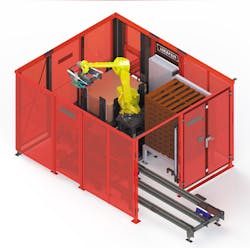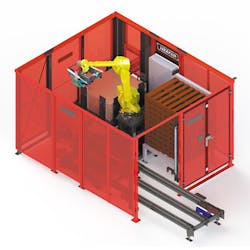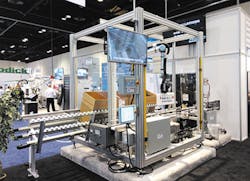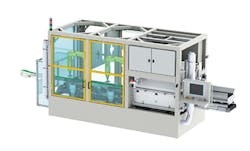From the robot asking to see attendees' badges in South Hall to the integrated work cells running throughout the Orange County Convention Center, the increasing role played by automation was on display everywhere at NPE2018. Makers of robots and other automation touted their speed and flexibility, as well as advantages for specialty operations, such as the manufacture of health-care products. Designed to reduce labor requirements, the latest technologies also boasted features to make them easier to implement and use, even under changing conditions.
FLEXICELL
Flexicell featured information about its new Pallet Handling Robotic Palletizer, which is engineered for continuous operation on a single production line.
"This is our latest cell," said Stuart Cooper, VP of sales for Flexicell. "We started it this year. We have four of these [installed] and three in the works. It fully automates the process. The robot will pick a pallet from a stack and position it for loading. The full pallet is automatically discharged to a forklift pick-up point."
While plastics processors have long used robots for removing parts from molds, Flexicell specializes in helping manufacturers automate the process of handling finished parts for shipping.
"Manual labor is getting more and more difficult to find and more difficult to keep," Cooper said. "They are looking to use automation not only in the production, they are looking to take that automation all the way through the system."
The new pallet-handling system uses a TGW IntelliROL motorized roller conveyor with reference pusher for case infeed. A Fanuc M710iC/50H robot with a payload capacity of 110 pounds picks up an empty pallet from a magazine that can store 10 empty pallets and puts it at the palletizing location. The robot, equipped with Flexicell's vacuum gripper end-of-arm tooling (EOAT), picks up and places single cases onto the pallet until it is full. The full pallet is then sent by conveyor to a forklift pickup location. Therefore, the operator only has to load the pallet magazine with a stack of pallets and remove the finished pallets.
The cell also includes safety guarding and a light curtain at the pallet exit location. An Allen-Bradley PLC is mounted on a control cabinet to control the cell along with an Allen-Bradley color touch-screen HMI. Flexicell recently added the ability for production personnel to program pallet patterns and sequences directly from the HMI.
"We teach the pallet pattern through an HMI," Cooper said. "That translates it to the robot."
For example, he said, you can tell the system that you want to stack four cases across the width of the pallet 10 layers high. You also input the case sizes, and the robot will stack it accordingly, he said.
The cell can process up to 12 cases per minute with a maximum case weight of 40 pounds and a maximum pallet height of 72 inches.
HEKUMA
Hekuma demonstrated two versions of its HEKUflex automation system. In Arburg's booth, its newest version was handling disposable 30-milliliter medication cups, and, at the Engel booth, a version originally created for K2016 was handling toothbrushes.
Hekuma designs its systems using a modular principle, so that individual modules handling tasks such as part takeout, inspection and packaging can be added to or subtracted from the system quickly and without disrupting other modules' functions.
In its Arburg installation, the HEKUflex system used a side-entry robot to perform takeout of single-use PP medication cups from a two-cavity Hofstetter mold running on an Allrounder 470 A electric injection molding press.
Starting with an off-the-shelf Rockwell Automation LDL-series linear servo motor and an Allen-Bradley ControlLogix PLC, Hekuma designed all of the software to run the module. It also created end-of-arm tooling (EOAT) made of lightweight carbon fiber.
Hekuma sales manager Helmut Schmid said the system's magnetic drive was chosen because it has few moving parts, no belts and no drive pulleys. "[It] fits well to the medical applications. No wear, no dust coming from the belt," he said.
On each cycle, the EOAT slid into the open mold, and vacuum grippers pulled the finished parts into retainers made of polyoxymethylene (POM). The robot slid out of the mold and the cups were pulled out of the retainers and transferred to a simple slide that dropped them into a bin. It achieved a take-out time of less than 0.2 second and cycle time of 2.8 seconds, offering an throughput of more than 2,500 parts per hour.
The system on display was greatly simplified; Schmid said that it could be easily scaled up, with possible modifications to the EOAT to handle as many as 32 cavities and the addition of modules such as a vision camera, stacking station, laser marking, etc.
Hekuma sees this flexibility as a huge bonus for customers, allowing the operator to expand or downsize the system to match changes in the market and also save costs.
PROCO MACHINERY
Proco Machinery demonstrated its newly redesigned Robo-Packer Collaborative Robot Case Packer, an automated system for packaging blow molded bottles.
The Robo Packer system, which is centered around a UR10 collaborative robot from Universal Robots, works alongside humans, requires no special guarding and needs minimal programming for new tasks. The system costs 50 percent less than automation solutions using conventional robots, said Siva Krish, VP of sales for Proco.
"These systems are being designed in such a way that they complement the production line and provide simplified operation, a smaller footprint and enhanced efficiencies," Krish said. "These collaborative robotic systems reduce the handling of the container and provide an excellent return on investment."
The Robo Packer basic system is equipped with a six-axis robotic arm, infeed conveyor and a box conveyor, all mounted onto a common subframe, which in turn is fitted with leveling pads and casters.
"The cell is a complete system with a frame, with light curtains, with safety features, with an infeed bottle conveyor and an infeed box conveyor," Krish said. "It has all the bells and whistles that you require for a packer to work efficiently."
The cell quickly can be wheeled into position, set up and put into production. The Robo Packer can be programmed to pack bottles with their necks up or down in a case using either row-by-row or full-layer packing methods. In situations where a standard configuration doesn't meet a customer's needs, Proco's engineering team can develop a custom system.
A box-alignment system ensures the box is in the proper position, and a box-spreader mechanism opens the box to ensure it is square prior to packing.
For one recent customer, Proco installed Robo Packer cells for packaging wide-mouth canisters at a rate of 30 bottles per minute for each line.
The Proco cell provided a solution despite tight space, demanding changeovers and the customer's need for an 18-pack configuration for each line. The customer reduced its labor needs, going from three people to one person per shift for both lines at a major cost reduction. The customer saw a return on investment in about 15 months.
Packing configurations can quickly be altered by entering information into the unit's PLC to change criteria like bottle size, bottle orientation and the number of bottles packed per row.
"The system configures itself automatically to do it," Krish said. "Everything has been preprogrammed, and we have developed the software to take care of all the needs of the customer."
The PLC contains preloaded information about frequently requested packaging patterns that can be selected with the press of a button. In some cases, an operator might need to change the EOAT.
The new Proco Robo Packer has quick-release tooling, which speeds changeovers when packing different bottle types or configurations.
"All they need to do is remove the lock, pull the tooling off, put the new set of tooling in, push the lock button, and the tooling stays there," Krish said.
The Robo Packer also is available with a new, patent-pending EOAT tentatively called Sleeve Fit. The EOAT, which holds the bottles while they are packed in a carton, is covered with a sleeve containing a blend of polymers designed to reduce friction. The result is operators can pack more bottles into each carton because they don't need as much space between rows of bottles.
Proco introduced the first version of the Robo Packer in 2017. However, a redesigned version, which has an aluminum frame instead of steel, was new for NPE. The lighter metal means the machine is easier to move within a plant.
In addition, the redesigned version has a new control panel with a larger screen and enhanced capabilities that allow for greater programming flexibility. The ability to easily switch packaging configurations with a push of a button is one of the major enhancements, Krish said.
DELTA ENGINEERING
Delta Engineering exhibited its Delta Bottle Picker DBP102. This bottle unscrambler transfers containers from a blow molding machine to downstream conveyors. Using a vision system, it locates each bottle, then passes the coordinates to a pair of robot arms. Each robot picks up a bottle (whether symmetrical or asymmetrical), orients it and places it on the exit conveyor.
The bottle picker saves "recipes" for handling different bottle types, allowing for quick changeovers to saved bottle types. A software wizard helps the operator teach the machine new bottle types in about 15 minutes, while saved bottle recipes can be activated with the push of a single button. The bottle picker can handle any shape of bottle without scratching or damaging it. It offers throughputs of as many as 2,400 bottles per hour per robot.
Bruce Geiselman, senior staff reporter
Contact:
Delta Engineering Inc.,
Duluth, Ga., 678-250-6356,www.delta-engineering-usa.com
Flexicell Inc.,
Ashland, Va., 804-550-7300,www.flexicell.com
Hekuma GmbH, Hallbergmoos, Germany, www.hekuma.com;U.S. sales representative Jan Nietsch,949-887-8897
Proco Machinery Inc.,
Mississauga, Ontario, 905-602-6066,www.procomachinery.com
About the Author
Bruce Geiselman
Senior Staff Reporter Bruce Geiselman covers extrusion, blow molding, additive manufacturing, automation and end markets including automotive and packaging. He also writes features, including In Other Words and Problem Solved, for Plastics Machinery & Manufacturing, Plastics Recycling and The Journal of Blow Molding. He has extensive experience in daily and magazine journalism.



